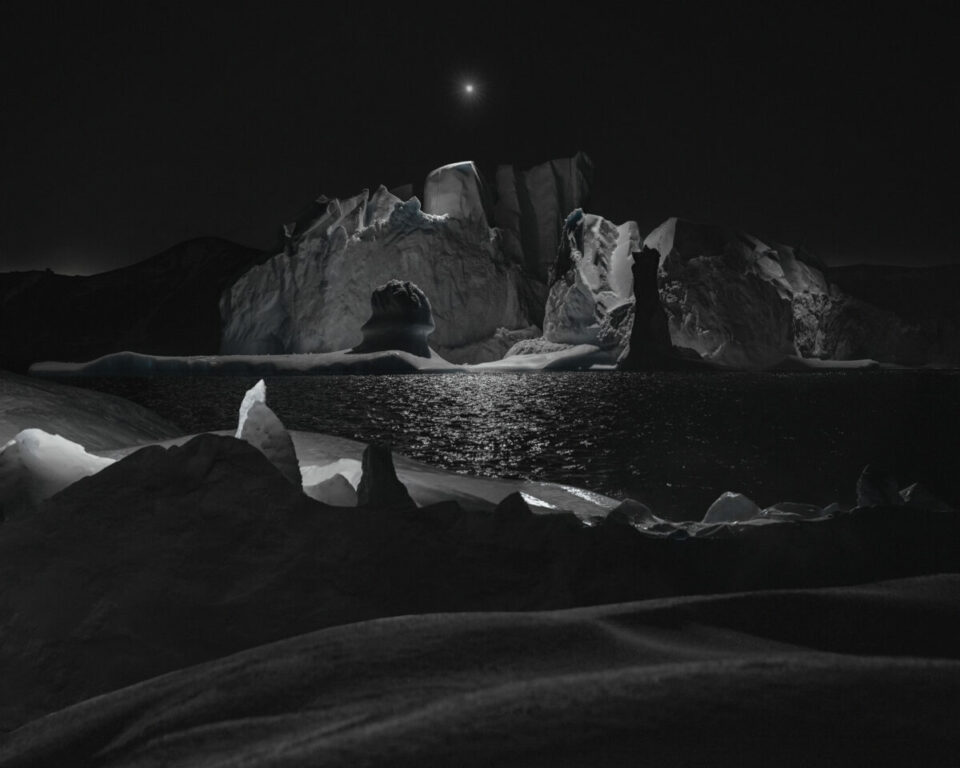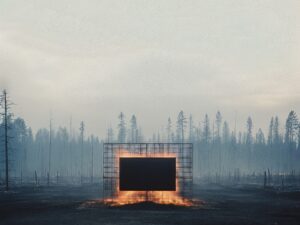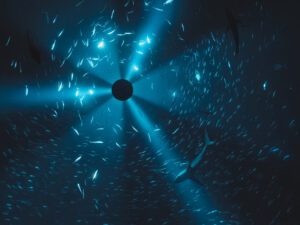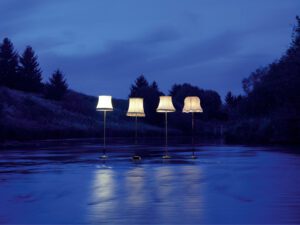Half of the world’s glaciers will vanish by 2100. Recent new reports state that policy-makers will not meet the aspirational 1.5°C temperature rise target set out at the 2015 Paris Climate Accords. In January 2023, the journal Science published an examination of the 215,000 land-based glaciers worldwide, using two decades of satellite data. The conclusion was startling: 49% would disappear at the lowest rate of global heating. However, the world is now on track for a 2.7°C rise since pre-industrial times, leading to a loss of 68% of ice caps. A reduction in CO2 emissions could curtail the shrinkage but, as the study’s co-author, glaciologist Regin Hock explains “for many small glaciers, it is too late.”
This widespread deglaciation will affect sea levels, water resources and increase natural hazards, threatening the safety and livelihoods of almost two billion people across the world in subsequent decades. In South America, for example, the reduction in the Andes’ tropical glaciers is disproportionately affecting indigenous communities – impacting essential services like hydro-electric power generation and causing water shortages. In March 2023, Leticia Carvalho, Principal Coordinator of the United Nations Environment Programme’s (UNEP) Marine and Freshwater Branch stated: “Indigenous peoples and local communities are least responsible for the emissions driving climate change, and are the best custodians of nature. But they will have no choice but to adapt to potentially very harsh circumstances and new ways of life that may not be as harmonious with nature as before.” This is a stark and confronting situation.
Elsewhere, Switzerland’s mountains have lost more than half of their glacial volume in the last century. The country is referred to as the “water tower of Europe,” with surface water flowing through a river network of nearly 65,000 kilometres, including the Adige, Danube, Po, Rhine and Rhone. It conserves approximately 6% of the continent’s water yet, as they melt, this reserve plummets. For Neil Entwistle, Professor of River Science and Climate Resilience at the University of Salford, the scale of ice retreat – and the looming threat of future devastation – can only be described as “extreme.”
This superlative is what French-Swiss artist Julian Charrière (b.1987) has conveyed through urgent multidisciplinary work, following an initial journey to the polar regions for the Antarctic Biennale in 2017. The Berlin-based practitioner bridges anthropology, art and environmental science – spanning performance, photography, sculpture and video. Most recently, in December 2022, the practitioner won the 14th SAM Prize for Contemporary Art, and his project, Stone Speaker, will be presented in 2024 at Paris’ Palais de Tokyo.
The extent of current ecological degradation is critiqued through projects that stem from remote fieldwork in “places with acute geophysical identities,” from ice fields and volcanoes to palm oil plantations and radioactive sites. These vast landscapes are barren, surreal and thought-provoking, where human interference is not only evident but extensive.
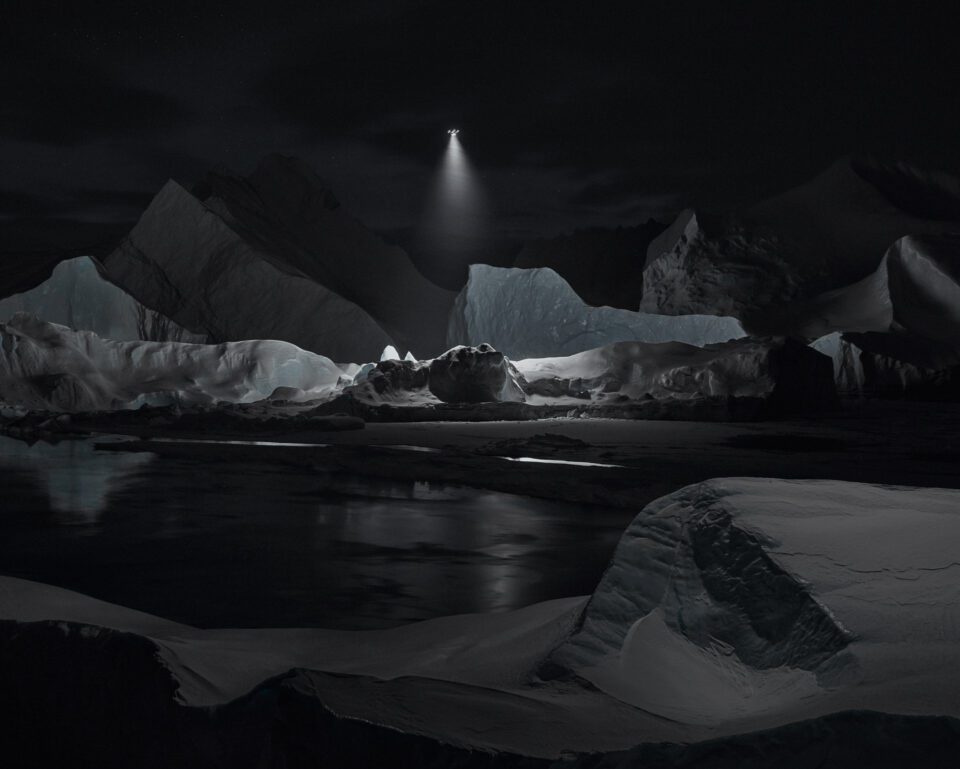
Charrière “gives the dark side of the polar region a new voice” in Towards No Earthly Pole (2019). The 104-minute film most recently became the focal installation in Erratic, an exhibition at San Francisco’s Museum of Modern Art, which ran until 14 May. It is a disorientating viewing experience: jutting crags evidence the slow erosion of ice, and spherical light creeps from the corners of dark compositions like an otherworldly moon, an iceberg’s reflection scattered across the waters. This sense of immersion removes the boundaries between the observer and the surrounding work, meditating on the innate links between humanity and the landscape.
The film is “intentionally confounding, drawing on the uncanniness of the polar nighttime.” Ethereal footage from the artist’s various expeditions to the Antarctic, Greenland, Iceland and the Swiss Alps combine with no reference to place or location. Each shot melts into the next, an affecting visual reminder of the landscape’s impending reduction. Only half a decade after the artist began depicting cryospheres, the future of these icebergs is already looking far bleaker.
The eerie soundscape accompanying the piece reinforces this sense of time passing. Ice cracks and water flows across crags, splitting the frozen landscape in shudders. It recalls the moment of “calving,” the cleaving of large blocks of ice from the front of glacier to form icebergs. Beneath the surface of this fear, however, Charrière’s footage posits these masses as alive and evolving, carrying a sliver of hope.
Journalistic reports, academic papers and social media doomscrolls have culminated in a scientific documentation of glacial regions within humanity’s collective imagination. Yet, the artist subverts this traditional framing – of light, airy images with azure skies and an almost luminous glow emanating from the cavernous mouths of ice structures. Instead, Charrière “peels back the media image because familiarity breeds passivity. These are ecologies on the brink of dissolve, and we need to find a way re-engage with them.”
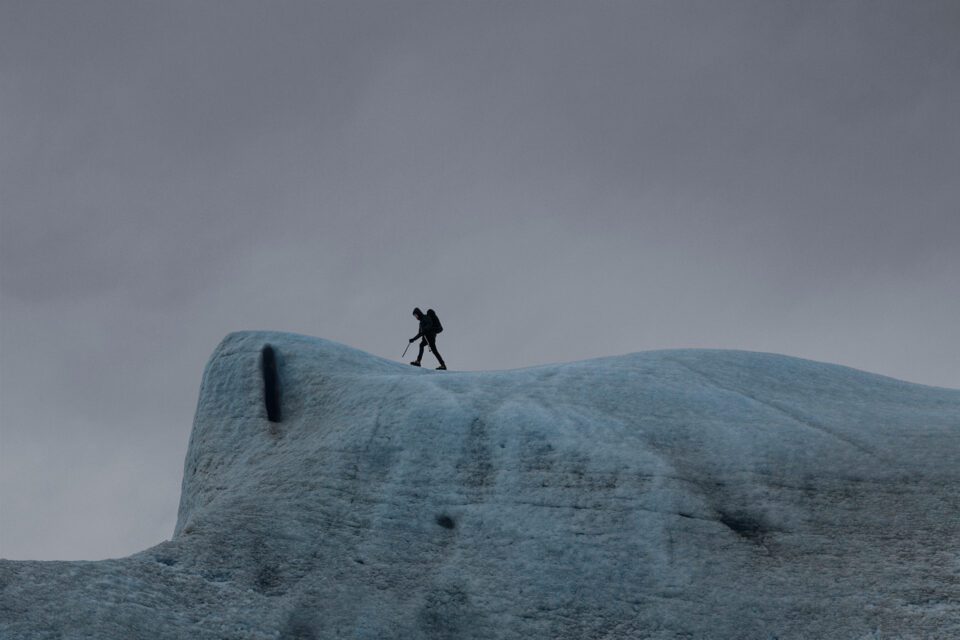
Each image is the result of the artist’s customised technological equipment, developed with a Berlin-based team who produce specialised drones that carry spotlights and cameras. The sparse glints of light that characterise the film were inspired by photographer Frank Hurley (1885- 1962), who chronicled the experience of 18 months stranded on the Antarctic ice sheets as part of Sir Ernest Shackleton’s famous 1914 voyage. Charrière told Artnet journalist Taylor Dafoe in 2020: “He used up to 30 mechanised flashes, creating this very strange kind of black-and-white stage photography. Because there was light all around the object, the photo looked very flat – it became almost like a scan.”
This survey of vast geographical plains from an aerial viewpoint is reminiscent of the growing community of contemporary photographers committed to documenting changes to the natural world. The large-scale photographic works of Edward Burtynsky’s (b. 1955), for example, which highlight the extensive and longstanding reverberations humanity has caused across the African landscape. Trees encroach on a gradient of brown and green in Tea Plantations #4, Near Kericho, of Kenya (2017), whilst incised parallel lines striate the industrial landscapes of Salt Ponds #6, Near Tikat of Banguel, Senegal (2019). These altered vistas reveal the staggering impact of mineral extraction, industrial activity and systematic land clearance from an aerial perspective.
Elsewhere, Richard Mosse (b. 1980) depicts the destruction and devastation of deforestation in the Amazon – an area spanning 6.7 million km2 – in Broken Spectre (2022). Desolate, cleared landscapes are juxtaposed next to the remaining woodland, saturated in vivid, hyperreal palettes of amber, bronze and cerise pink. These testimonials “echo ubiquitous photographs of burning trees,” the artist notes. The scenes invite viewers to zoom out and focus on the scale of ecological crisis, to examine imminent social disaster anew.
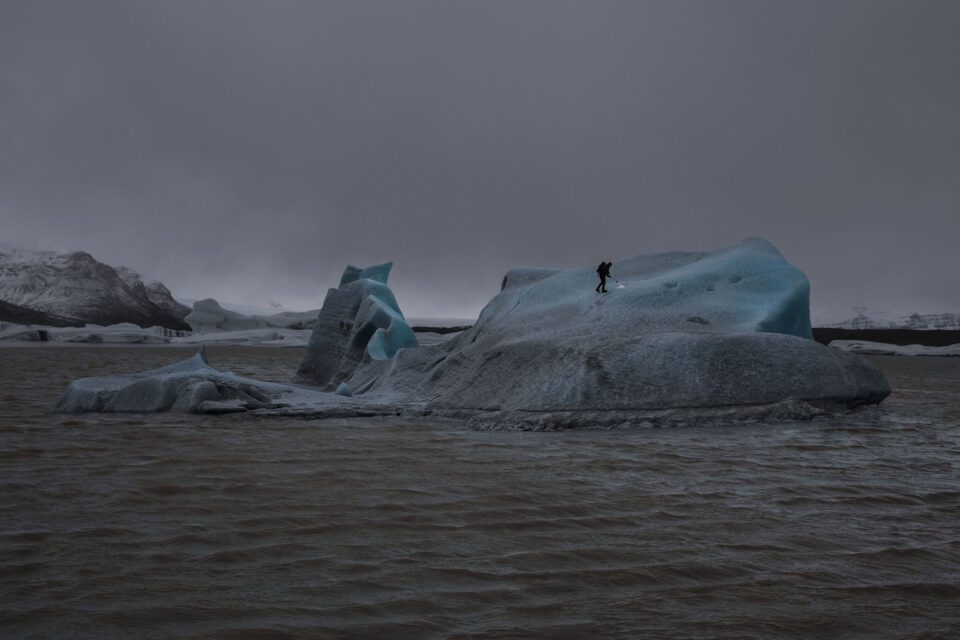
These approaches provide expansive and outward-looking reflections of the landscape, forcing us to visualise what is often left unseen. For Anastasia Samoylova (b. 1984), this involves transforming views of the “sunshine state” Florida from a tourist hotspot – characterised by Disneyland and Universal Studios – to its meteorological reality. The region has experienced a flurry of storms in 2023, causing flooding, landslides and heavy snowfall. Samoylova’s images of swollen palm trees, sunken furniture and floating debris transform icons of Americana into a frightening reality.
Charrière’s practice centres on shifting the observer’s focus. “The act of the expedition is to physically experience places that exist to us mainly in images, and to stage with them an embodied encounter.” Perceptions are especially distorted within the hostile regions he explores. “Polar night” is a phenomenon that occurs in the northern and southernmost circles. During this period – several months – the sun does not rise above the horizon for more than 24 hours. Days pass without sunlight and the cold leeches all warmth from gas fires. It is under these challenging conditions that Charrière thrives. The intensity of the journeys – in which reality is reconfigured and time re-evaluated – becomes a metaphor for the precarious nature of his surrounding environments.
Not All Who Wander Are Lost (2019) is a set of “erratics” – boulders once carried by glaciers – now dislocated from their original positions and perforated by core-drilling. This installation was first exhibited in Switzerland, but the rocks have since travelled from to Venice and San Francisco. Each rests on a plinth of its own core, whilst bronze and copper fragments attach to several cylinders, representing the expansion periods of human history. Charrière highlights that “they not only markers in the landscape, but in time.”
Contrastingly, The Blue Fossil Entropic Stories (2013) visualises an “urgent and imbalanced” knife-edge between humanity and nature. Charrière poses as an insignificant silhouette against the enormity of the landscape, spending eight hours melting an iceberg with a gas blowtorch. The image is striking, the artist positioned as an adversary against the vast, imposing structure. The contrast between figure and glacier reiterates humankind’s relative insignificance when faced with the daunting scale of an ever-expanding universe.
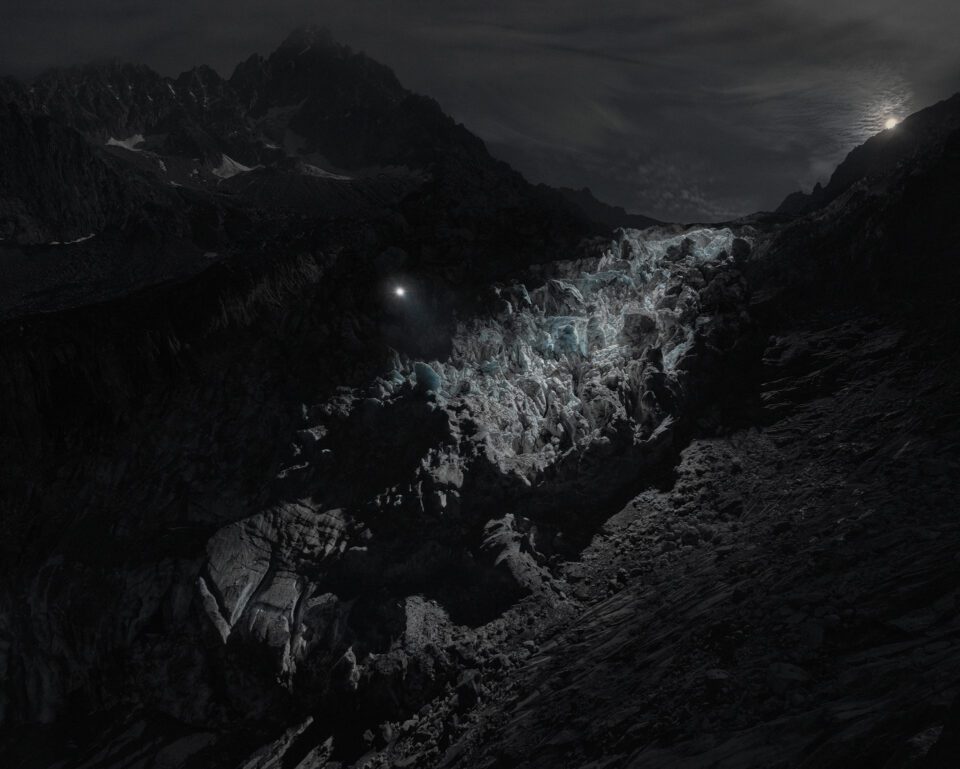
The performance does critique the continued burning of fossil fuels, but it is also evidence of “a seemingly hopeless battle of human time against geological time,” the artist states. Most glaciers are relics of the last ice age, which ended more than 12,000 years ago. This is difficult to comprehend for a species whose average lifespan is between 70-80 years.
Other artists working in this realm include Noémie Goudal (b. 1984), who uses deep time and geological history to inform her work. Décantation (2021) focuses on paleoclimatology – the scientific study of past climates to speculate on the future. “I’m not trying to talk about climate change directly,” she states. However, “if you look at a landscape, it’s the first thing that comes to mind.” This crisis is the defining issue of our time; it has become almost impossible to isolate depictions of the landscape from ecological undertones.
Charrière creates a place where the indelible links between geographical history and human evolution are brought into focus, where ancient boulders are “moved by the art world.” Perhaps, with this outlook, humanity can change course too.
Towards No Earthly Pole, Aargauer Kunsthaus
Words: Megan Jones
Image credits:
1.Julian Charrière, Towards No Earthly Pole – Sovetskaya, (2019). Copyright the artist; VG Bild-Kunst, Bonn, Germany.
2.Julian Charrière, Towards No Earthly Pole – Vostok, (2019). Copyright the artist; VG Bild-Kunst, Bonn, Germany.
3.Julian Charrière, The Blue Fossil Entropic Stories (detail),(2013). Copyright the artist; VG Bild-Kunst, Bonn, Germany.
4.Julian Charrière, The Blue Fossil Entropic Stories I, (2013). Copyright the artist; VG Bild-Kunst, Bonn, Germany.
5. Julian Charrière, Towards No Earthly Pole – Mercer, (2019). Copyright the artist; VG Bild-Kunst, Bonn, Germany.


